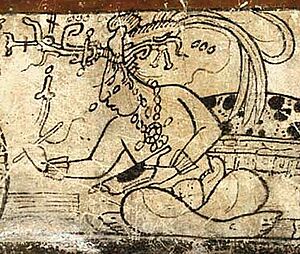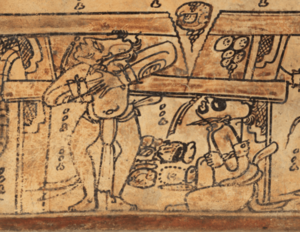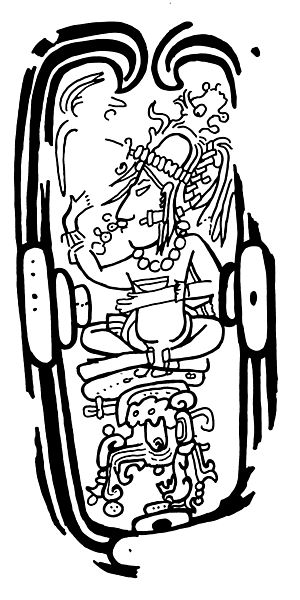Maya maize god facts for kids
The ancient Maya people, like many others in Mesoamerica, saw their main crop, maize (corn), as a very important part of life. They felt a strong connection to it. This is clear in their old stories. For example, the 16th-century book called the Popol Vuh tells us that the Hero Twins had maize plants as their special companions. It also says that humans themselves were created from maize. One of the most popular Maya stories is about finding and opening the Maize Mountain, where all the corn seeds were hidden. During the Classic period (200-900 AD), the maize god was seen as a kind of culture hero, someone who brought important things to people.
Contents
Maize as Male and Female
In many Maya spoken traditions, maize is often thought of as a woman. This is similar to how rice is seen in Southeast Asia or wheat in ancient Greece and Rome. One common Maya myth tells how this maize woman was found and taken as a bride.
However, the Maya nobles before the Spanish arrived mostly saw maize as male. During the Classic period, there were two main male forms of the maize god:
- A foliated (leafy) maize god, who looks like a plant with leaves.
- A tonsured (shaved head) maize god.
The leafy god can be seen in the famous "maize tree" carving at the Temple of the Foliated Cross in Palenque. Here, the corn cobs look like the god's head. This leafy maize god, sometimes called God E, also appears in the three surviving Maya hieroglyphic books.
The tonsured maize god is more complex than the leafy one. He has many different roles. When shown in ceremonies, he often wears a skirt made of jade beads and a belt with a large spondylus shell covering his waist. On tall stone monuments called stelae, it's often a queen, not a king, who represents the tonsured maize god. This makes the queen appear as a maize goddess, which fits with the Maya stories where maize is seen as female.
Ancient Maya Maize Stories
Many ancient Maya paintings, especially those on cups used for cacao drinks, show that there were many rich stories about the tonsured maize god. Very old murals from San Bartolo prove how ancient these myths are. Scholars have come up with different ideas to explain parts of these stories, such as the maize god rising from a turtle shell, his journey in a canoe, or how he changed into a cacao tree.
Maize God and the Hero Twins
The tonsured maize god is often shown together with the Hero Twins. Many experts believe that the tonsured maize god, who comes back to life in Classic Maya art, is the same as the father of the Hero Twins in the Popol Vuh. This father is named Hun-Hunahpu.
Maize God and Creation
Some researchers, like Linda Schele, have focused on the maize god's role in creation. They believe the tonsured maize god, sometimes called "first father," was central to how the world was made. This includes:
- Setting up the "three-stone hearth," which might represent a group of stars.
- Raising the world tree, which connects the sky, earth, and underworld.
- Performing a "dance of creation."
- Appearing as an acrobat, which also seems to represent the central world tree.
The maize god's presence among five world trees in the San Bartolo murals has been seen as him creating the world.
Maize God and the Seasons
Another idea, from Simon Martin, looks at how the tonsured maize god interacts with an old jaguar god of trade, known as God L. This interaction is linked to the hero changing into a cacao tree, which was seen as a "trophy tree." God L is thought to have ruled over the dry season, which was a time for long-distance trade, warfare, and harvesting cacao. The Tonsured Maize God, on the other hand, was linked to the wet season and the growth of maize. It is believed that the start of these two seasons was shown by the defeat of the maize god and God L, respectively.
Maize Myths from the Gulf Coast
In many ancient Maya scenes, water is very important (see Fig. 2). The most famous example is the maize god rising from the shell of a turtle floating on the water. This watery setting is also a key part of an important maize myth shared by many groups living on Mexico's Gulf Coast, such as the Huaxtecs, Totonacs, Nahuas, and Zoques. This myth focuses on a male maize god and connects him closely with the turtle. This suggests that the Classic Maya might have shared this story tradition. For example, the Pre-Classic Maya maize god dancing with a turtle drum among water deities at San Bartolo may be connected to a Zoque (Popoluca) version of the Gulf Coast maize myth.
Names and Calendar Connections
Some names for the pre-Spanish maize god appear in the Book of Chilam Balam of Chumayel. These include ah mun (meaning "tender green shoot") and zac uac nal (meaning "white six new corn"). The tonsured maize god has often been called "first father."
Maize is generally connected to the Maya day Qʼan, which means "ripe" or "ripeness." The tonsured maize god's appearance is linked to the starting date of the Maya Long Count calendar, which is 4 Ahau 8 Cumku. The head of the tonsured maize god is used to represent the number 1, while the head of the foliated maize god represents the number 8. The tonsured maize god is sometimes shown with the crescent moon, suggesting he might have played a role in how the lunar calendar was divided. His head also seems to appear in a specific glyph (symbol) in the Lunar Series, which tracks moon cycles (see also Maya moon goddess).
See also
 In Spanish: Dios maya del maíz para niños
In Spanish: Dios maya del maíz para niños




